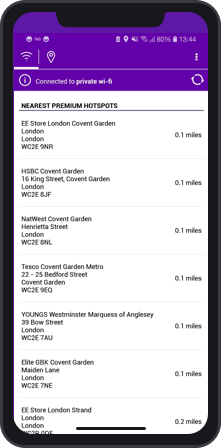Before you start
Before you can connect to the internet by wireless, you need:
- Mobile device with wireless capabilities (e.g. laptop, tablet or smartphone)
- BT Broadband or BT Mobile (which comes with unlimited free BT Wi-Fi minutes) or a BT Openzone subscription or voucher.
- Your account username and password
Please check that:
- You've selected one of the BT Wi-Fi networks (eg BTOpenzone or BTWifi)
- If you're going to access a company network, make sure you've disabled Internet Explorer proxy settings. If you need some help, please go to how to login with BT Wi-Fi
- when logging in to BT Wi-Fi, you've typed your username and password correctly - remember no capital letters and please check spelling (if you've copied and pasted your username or password, make sure there's no space after it)
Technical details
BT Wi-Fi provides businesses with a convenient wi-fi service they can offer their customers and other visitors.
- Both the 2.4Ghz and 5Ghz radio frequencies
- Our wireless access points support 802.11a,b,g,n standards with connection speeds of up to 144 Mbps*
- The typical range of a wireless access point is up to 50 meters indoors and 100 meters outdoors.
*At a Modulation Coding Scheme Index of 15
Need technical help?
If you've a problem, please see our FAQs. If you still need some help, call us on:
- Freefone 0800 022 33 22* (24/7) or
- +44 132 556 0841 from outside the UK **.
* Calls to 0800 numbers are free from UK landlines and Mobiles. Mobile costs may vary. Check out bt.com/pricing for details.
** International number is charged at your telephone provider's international call rates.
Wireless Standards
BT Wi-Fi protects the integrity of its network and follows standard wireless security measures to protect your wireless device, including authentication and account security.
Wireless device security
Please be aware of the following steps you can take to protect your data:
- consider using a robust and updateable anti-virus software and personal firewall
- turn off any automatic login facilities (i.e. if you've set your computer to remember passwords)
- use a secure Virtual Private Network (VPN) to access your corporate network or intranet
- enter any personal and banking details only when the site is secure (i.e. look for the padlock icon on your browser and click on it to confirm that the security certificate is valid).
Important: if you're using Windows XP (SP2) and view wireless connection status, you'll see BT Wi-Fi described as an 'Unsecure network' or similar. Windows XP (SP2) describes most public access wireless networks in this way. Please ignore this. BT Wi-Fi uses sophisticated 128-bit public key encryption during login to protect transfer of your data. Account traffic is encrypted and your account is password protected.
Authentication and account security
128-bit Secure Sockets Layer (SSL) is used when:
- logging in to use BT Wi-Fi
- purchasing a pricing plan
- changing your password
- checking your profile details.
When you choose to launch a new browser window to surf the web, depending on your chosen web site, your session may no longer use SSL. This is no different from normal use of the internet.
Network integrity
Our network uses:
- firewall protection to our access routers to help stop hackers
- dedicated IP network access to the internet
- individual addressing for customers (i.e. each valid user has an individual session ID)
- data centre firewalls
- an Intrusion Detection System (IDS) at central sites
- 'a walled garden' (i.e. traffic from outside a BT Wi-Fi hotspot is only allowed from authorised servers using our data centre)
Please note: war-chalking (marking a building, pavement or site to tell others a wi-fi network is present) doesn't affect BT Wi-Fi hotspots as all our users must authenticate to login.
Is WEP enabled for BT Wi-Fi?
Wired Equivalent Privacy (WEP) is a security protocol designed to provide a wireless LAN with a level of security and privacy comparable to what is usually expected of a wired LAN - by encrypting data transmitted over the WLAN.
WEP is not enabled for BT Wi-Fi (i.e. no on-air wireless encryption is used), because BT Wi-Fi is a public access wireless local area network (WLAN). However, other security measures are in place when accessing BT Wi-Fi, such as logging in with a unique username and password. We recommend that access to a company network should be via a virtual private network (VPN), and that whenever you're sending personal data, you make sure SSL is in place.




